Birds in Gyeonggi are some of the most diverse and exciting birds in the world. Gyeonggi is home to a wide range of avian species, from the majestic cranes that migrate to the area to the colorful songbirds that flit around the forests and gardens.
From the shorebirds that inhabit the coastal wetlands to the raptors that soar over the mountains, Gyeonggi has a rich and varied bird population that is well worth exploring.
Whether you’re an experienced birder or just starting, Gyeonggi is an ideal destination for birdwatching.
24 Birds to Watch in Gyeonggi
Gyeonggi is a province in South Korea that surrounds the capital city of Seoul. It is a region rich in history, culture, and nature. One of the best ways to enjoy the natural beauty of Gyeonggi is to go bird-watching.
The province is home to a wide variety of birds, from common species to rare and endangered ones. Whether you are a beginner or an expert, you will find something to marvel at in Gyeonggi’s avian diversity.
Here are 24 birds to watch in Gyeonggi.
1. Common Cuckoo
The common cuckoo is a species of bird that belongs to the Cuculiformes order, a group of birds that includes roadrunners, anis, and coucals. These birds are found worldwide, but the common cuckoo is especially widespread in Europe and Asia.
It migrates to these regions for the summer season and then migrates south for the winter, typically to Africa. The common cuckoo is known for its distinctive call, which is why it is called a cuckoo bird.
This species is also known for its unique behavior: it is a brood parasite, which means it lays its eggs in the nests of other birds and then leaves them to hatch.
The young cuckoos then outcompete the other birds for food, allowing the cuckoo to survive and thrive. The common cuckoo is a highly adaptable bird and can survive in various habitats, from forests and grasslands to urban areas.
This species is also quite large, with a wingspan of up to 39 inches and a body length of around 13 inches. The common cuckoo is a valuable part of the ecosystem, as it helps to keep insect populations in check.
| Kingdom | Animalia |
| Phylum | Chordata |
| Class | Aves |
| Order | Cuculiformes |
| Family | Cuculidae |
| Genus | Cuculus |
| Species | C. canorus |
2. White-naped Crane
The white-naped crane is a majestic bird that belongs to the crane family. It is significant, measuring between 112 and 125 cm long and about 130 cm tall. In addition, it weighs a hefty 5.6 kg.
Its legs are pinkish, and its neck is striped with shades of grey and white.
A distinctive feature of the white-naped crane is its red face patch, which stands out against its otherwise muted plumage. White-naped cranes are found in East Asia, including China, Korea, and Mongolia.
They inhabit wetlands, such as marshes, and are known to migrate long distances in search of food.
These birds feed primarily on small aquatic animals, such as fish and insects, as well as grains and other vegetation. White-naped cranes are considered vulnerable due to habitat loss, hunting, and other threats posed by human activities.
Conservation efforts are underway to ensure that these majestic birds remain a part of our planet for future generations.
| Kingdom | Animalia |
| Phylum | Chordata |
| Class | Aves |
| Order | Gruiformes |
| Family | Gruidae |
| Genus | Antigone |
| Species | A. vipio |
3. Baikal Teal
The Baikal teal is a dabbling duck found in eastern Russia. It is also known by two other names, the bimaculate duck and the squawk duck. It is a migratory species, breeding in eastern Russia in the summertime and migrating to East Asia during the winter.
Its scientific name is Anas formosa, the smallest of all the dabbling ducks. Males typically have a light grey-brown color with dark brown and black markings. They also have a large white patch on their wings. Females are a tan color with dark brown and black markings.
It is typically found in shallow wetlands near coasts and lakes. The Baikal teal mainly feeds on aquatic plants, insects, and mollusks. They are also known to eat small fish and crustaceans.
The Baikal teal is an essential species in the birdwatching community, and its population is monitored closely by conservationists.
| Kingdom | Animalia |
| Phylum | Chordata |
| Class | Aves |
| Order | Anseriformes |
| Family | Anatidae |
| Genus | Sibirionetta |
| Species | S. formosa |
4. Ferruginous Duck
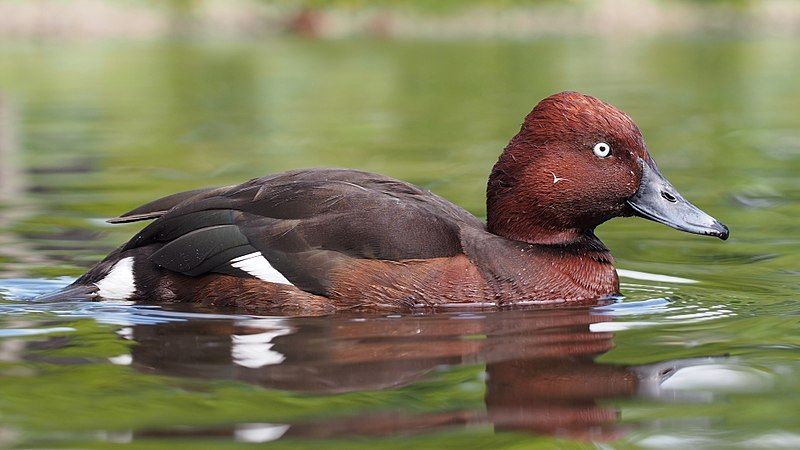
The ferruginous duck is a species of medium-sized diving duck that can be found throughout the Eurosiberia region. Several names know it, including ferruginous pochard, common white-eye, and white-eyed pochard.
The scientific name of this species is Aythya nyroca, derived from two sources. The first part, Aythya, comes from the Greek word Lithuania, which is used by authors such as Hesychius and Aristotle to refer to an unidentified seabird.
The second part, nyrok, comes from the Russian term for duck. This duck species has unique features that help it survive in its natural habitat. It has a large, broad, rounded head, prominent white eye-ring, and stout bill.
The upper parts of the body are a deep rusty-brown color, while the underparts are white. These ducks are also noted for their long and powerful wings and their ability to dive underwater while foraging for food.
The ferruginous duck is an essential species in the Eurosiberia region, as it helps to maintain healthy wetland habitats. It can also be found in large flocks, making it an impressive sight for birdwatchers.
Unfortunately, their population is declining due to various human-related issues, including habitat destruction and hunting. It is, therefore, essential to take action to protect this species and its natural environment.
| Kingdom | Animalia |
| Phylum | Chordata |
| Class | Aves |
| Order | Anseriformes |
| Family | Anatidae |
| Genus | Aythya |
| Species | A. nyroca |
5. Mandarin Duck
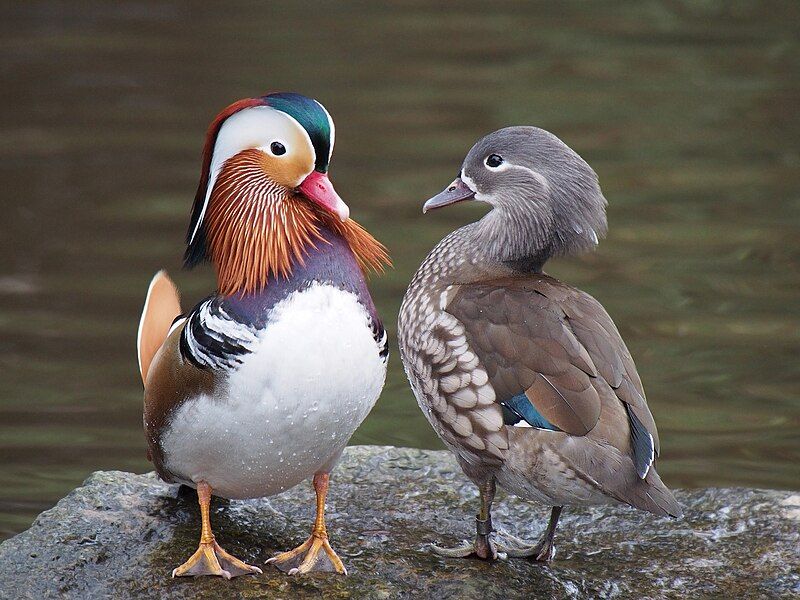
The mandarin duck is a unique species of perching duck found in the East Palearctic region. It stands out from other duck species due to its striking sexual dimorphism – males and females look different.
In terms of size, mandarin ducks measure between 41 and 49 cm long and have a wingspan of 65 to 75 cm. They are also closely related to the North American wood duck, sharing the same genus, Aix.
The male mandarin duck is perhaps the most distinct of all ducks, having vibrant red, orange, and yellow feathers and two white stripes at the back of the head. Its bill is also a bright orange-red with a light blue patch around its eyes.
The female, however, is more muted in color, with a brown body and a white eye-ring. The mandarin duck is a beautiful and unique species and is a remarkable example of nature’s beauty and variety.
Its striking appearance and close relationship to the wood duck make it an interesting species to observe and study.
| Kingdom | Animalia |
| Phylum | Chordata |
| Class | Aves |
| Order | Anseriformes |
| Family | Anatidae |
| Genus | Aix |
| Species | A. galericulata |
6. Cinereous Vulture
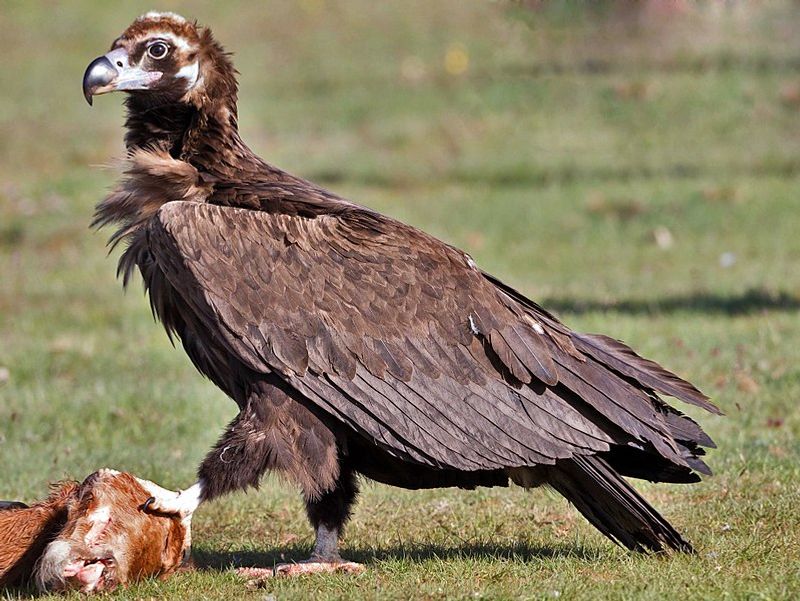
The cinereous vulture is a large member of the raptor family Accipitridae, found across a large area of temperate Eurasia. It has many different names, including the black vulture, monk vulture, and Eurasian black vulture.
This vulture species is usually found in its range’s open steppes and mountains, although it is also occasionally seen in cultivated areas. Its wingspan is approximately 1.5 meters, and its body is covered in blackish-brown feathers.
The cinereous vulture is an opportunistic feeder and will mainly feed on carrion, although it will also hunt small mammals and reptiles. It is known to scavenge and steal food from other raptors and raid other birds’ nests for food.
The cinereous vulture has a rather unique behavior in that it will often form groups of up to 30 birds to search for food. The cinereous vulture is listed as near threatened due to several factors, including habitat loss and degradation, poisoning, and illegal killing.
Conservation efforts are underway to protect the species and its habitat, but it is still at risk. If conservation efforts are successful, the future of the cinereous vulture looks promising.
| Kingdom | Animalia |
| Phylum | Chordata |
| Class | Aves |
| Order | Accipitriformes |
| Family | Accipitridae |
| Genus | Aegypius |
| Species | A. monachus |
7. Black-Faced Spoonbill
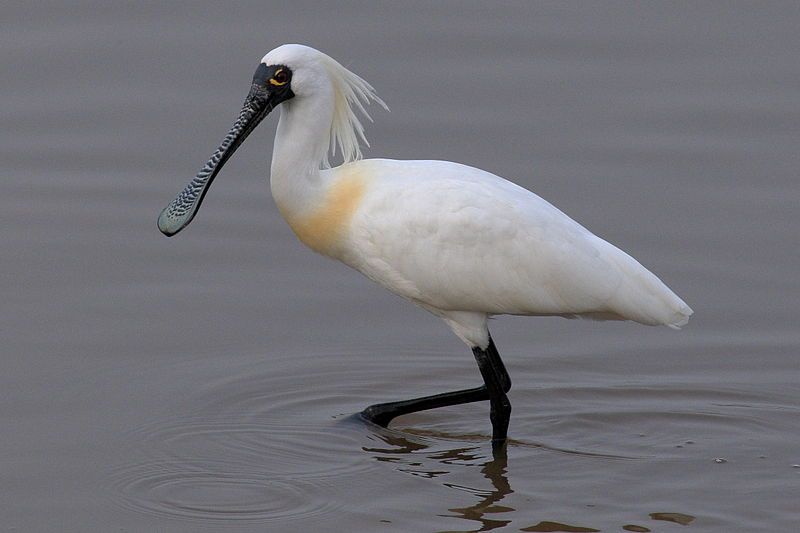
The black-faced spoonbill is a species of wading bird found in eastern Asia. It belongs to the ibis and spoonbill family, Threskiornithidae. This species is the most restricted regarding its geographical range compared to the other five spoonbill species.
It is unique in this regard, as it is the only species regarded as endangered. This means that its population is declining, and its survival is threatened. The reasons behind this are unclear, but it is likely due to habitat destruction and human activity.
Conservation efforts are being made to protect the species and its dwindling population, such as limiting hunting and protecting its wetland habitats. Hopefully, these efforts will help ensure the species’ survival for years to come.
| Kingdom | Animalia |
| Phylum | Chordata |
| Class | Aves |
| Order | Pelecaniformes |
| Family | Threskiornithidae |
| Genus | Platalea |
| Species | P. minor |
8. Common Shelduck
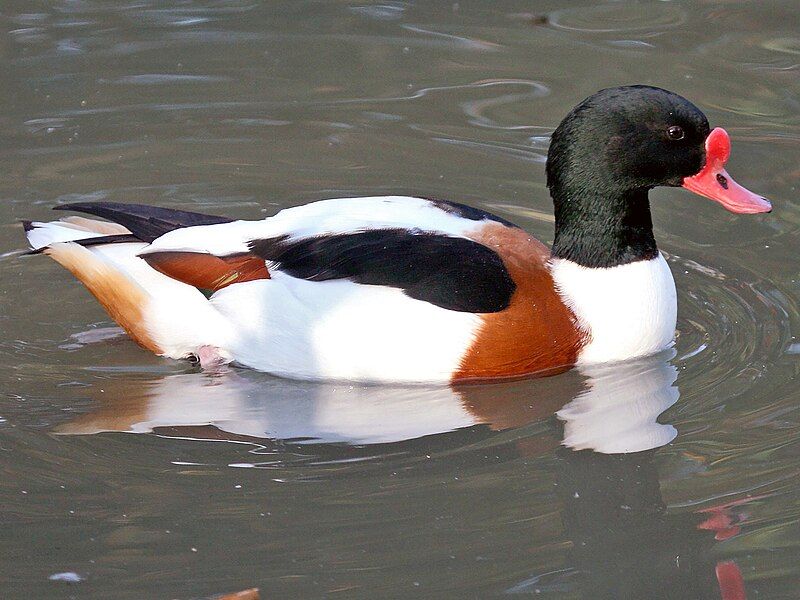
The common shelduck is a waterfowl species belonging to the shelduck genus Tadorna. It is widespread and abundant in the Euro-Siberian region of the Palearctic. This species mainly breeds in temperate climates and winters in subtropical areas.
During the winter months, it can also be found in the Maghreb. This species is highly adaptable and can live in various habitats and climates. The common shelduck feeds on various small animals, plants, and invertebrates.
It also grazes on grasses, grains, and other vegetation. The shelduck is an integral part of many ecosystems, as it helps maintain the balance of the food chain and provides food for different animals.
Additionally, it helps control insect populations and disperse seeds, which helps maintain healthy habitats.
| Kingdom | Animalia |
| Phylum | Chordata |
| Class | Aves |
| Order | Anseriformes |
| Family | Anatidae |
| Genus | Tadorna |
| Species | T. tadorna |
9. Oriental Turtle Dove
The Oriental Turtle Dove, also called the Rufous Turtle Dove, is a species of bird belonging to the Columbidae family. It is native to Central Asia, and its range extends eastwards across Asia to Japan.
This bird species is known for its wide range of plumage patterns, which have led to the identification of no less than six different subspecies. These subspecies are differentiated by the patterning of their plumage, such as the color and amount of markings.
The Oriental Turtle Dove is a relatively small bird with a wingspan of around 30 cm. It is brownish-grey, with a paler underside and white throat patch. It has a dark tail and red eyes.
Its call is a loud, repetitive coo-coo-coo-coo, often heard in the morning and evening. The Oriental Turtle Dove is a common breeding bird in various parts of its range, especially in urban areas.
It is often seen in gardens and parks, where it feeds on seeds and grains. It typically builds its nest in a tree or bush and lays two eggs at a time. Overall, the Oriental Turtle Dove is a widespread species with many subspecies.
It is a familiar sight in many parts of its native range, and its unique call is often heard in the morning and evening.
| Kingdom | Animalia |
| Phylum | Chordata |
| Class | Aves |
| Order | Columbiformes |
| Family | Columbidae |
| Genus | Streptopelia |
| Species | S. orientalis |
10. Grey Heron
The Grey Heron is a wading bird of the heron family Ardeidae found in many temperate parts of Europe, Asia, and Africa.
It is commonly seen in many parts of its range and typically remains in the same place year-round. Still, some Grey Herons from more northern areas may migrate southward during autumn when temperatures become more relaxed.
The Grey Heron has a long neck and long legs, allowing it to wade through shallow water in search of food. This species is typically found near bodies of water, such as lakes, rivers, and wetlands, where they hunt for fish, frogs, and other small aquatic animals.
The Grey Heron is a majestic bird with a wingspan of up to 6 feet, allowing it to soar gracefully through the sky. Its grey, white, and black plumage will enable it to blend in with its environment, making it a difficult bird to spot in the wild.
| Kingdom | Animalia |
| Phylum | Chordata |
| Class | Aves |
| Order | Pelecaniformes |
| Family | Ardeidae |
| Genus | Ardea |
| Species | A. cinerea |
11. Red-crowned Crane
The red-crowned crane, also known as the Manchurian crane, is a large, majestic bird native to East Asia. It is considered one of the rarest cranes in the world due to its declining population.
In many Asian cultures, the red-crowned crane is seen as a symbol of luck, longevity, and fidelity. The crane is believed to bring good fortune and increase one’s lifespan.
In addition, its loyalty to its mate symbolizes a solid relationship between two people. The crane symbolizes good luck, long life, and faithfulness in East Asian countries. As a result, it has been revered in many cultures for centuries.
The red-crowned crane is often seen in artwork, literature, and popular culture. For example, the crane is featured prominently in the Japanese anime film Princess Mononoke. In this movie, the red-crowned crane is seen as a great strength and beauty creature.
In addition, the crane has also been the subject of many traditional East Asian folk tales and stories, which remind people of the crane’s symbolism and importance in their culture.
| Kingdom | Animalia |
| Phylum | Chordata |
| Class | Aves |
| Order | Gruiformes |
| Family | Gruidae |
| Genus | Grus |
| Species | G. japonensis |
12. Daurian Redstart
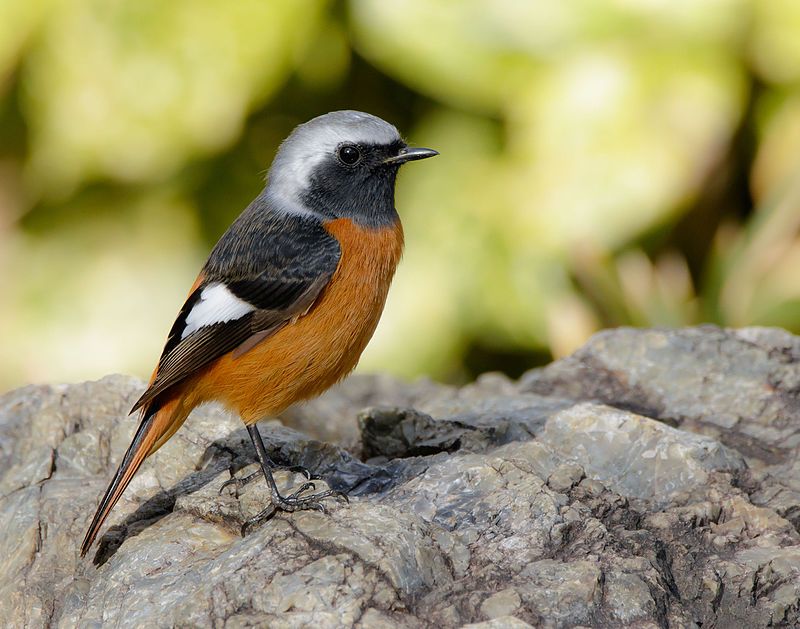
The Daurian redstart is a small passerine bird species native to temperate Asia. It was first described by the German-Russian naturalist Peter Simon Pallas in 1776. This species is a small bird, measuring 15-17 cm long and weighing between 12 and 18 g.
It has a distinctive rusty-red head and tail, a black crown, chest, white wings, and underparts. It feeds mainly on insects, spiders, and fruit.
The Daurian redstart inhabits various habitats, including woodlands, scrub, and grasslands, and breeds in open areas with scattered trees and bushes. Its range extends from eastern Siberia to Iran and the Himalayas.
It is generally a common species, though it is threatened by deforestation and overgrazing in some regions.
| Kingdom | Animalia |
| Phylum | Chordata |
| Class | Aves |
| Order | Passeriformes |
| Family | Muscicapidae |
| Genus | Phoenicurus |
| Species | P. auroreus |
13. Hill Pigeon
The hill pigeon, also known as the eastern rock dove or Turkestan hill dove, is a species of bird that belongs to the Columbidae family. These birds are found throughout the world, most of which live in the Middle East, Central Asia, and Eastern Europe.
The hill pigeon has a grayish-brown body with a white rump and a black tail. Its wings are long and pointed, and its head is slightly rounded. The legs and feet are usually red or yellow. The bill is typically red or orange, and its eyes are yellow.
It is a medium-sized bird, typically weighing between 5 and 7 ounces. Hill pigeons usually feed on grains, seeds, fruits, and insects. They live in large flocks and typically nest on cliffs or buildings.
They are very social birds and can be seen gathering in large groups in open areas. They also migrate long distances, up to several thousand miles. The hill pigeon is known to be a very vocal bird, often making loud, cooing noises.
They also have a variety of other calls, such as alarm calls and mating calls. They have various predators, including hawks, owls, and snakes. The hill pigeon is an important species for humans, as it has been used for centuries in hunting and racing.
It is also one of the oldest domesticated birds, with archaeological evidence showing that it has been kept as a pet since the Stone Age.
| Kingdom | Animalia |
| Phylum | Chordata |
| Class | Aves |
| Order | Columbiformes |
| Family | Columbidae |
| Genus | Columba |
| Species | C. rupestris |
14. Rock Dove
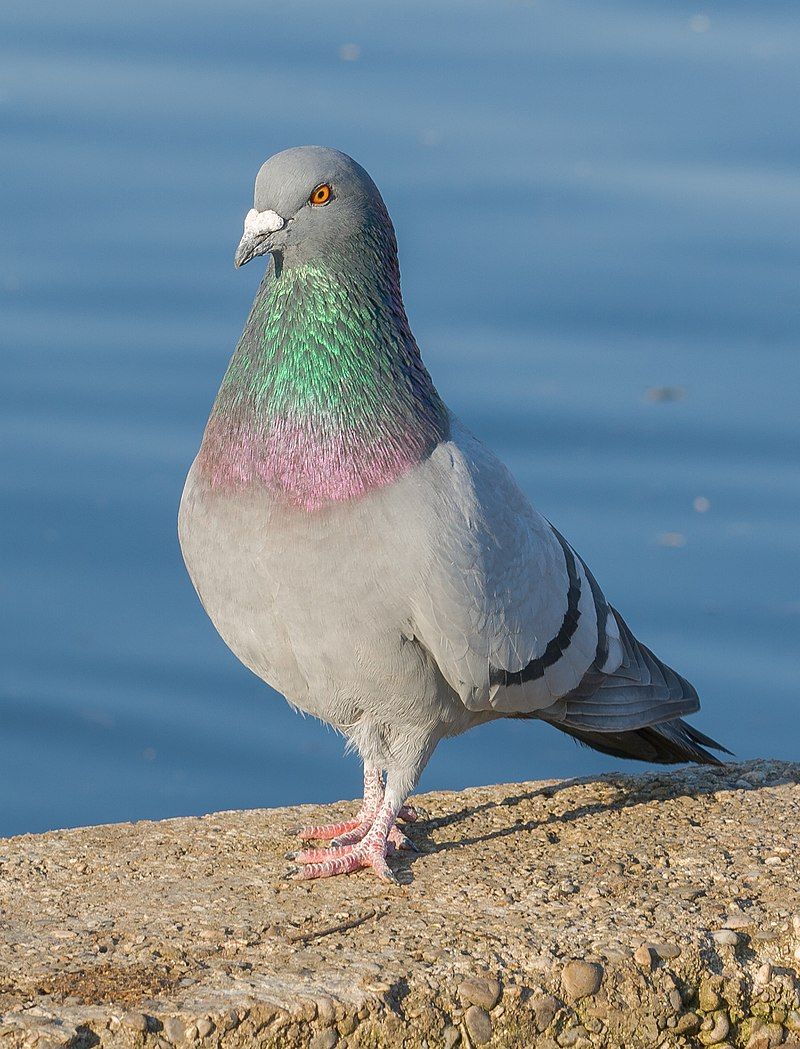
The rock dove, rock pigeon, or common pigeon is a species of bird that belongs to the Columbidae family. It is commonly referred to as the “pigeon” and is the ancestor of the domestic pigeon.
As a result of domestic pigeons escaping into the wild, their numbers have grown significantly in many parts of the world. This has increased the number of feral pigeons, the wild descendants of domestic pigeons.
These feral pigeons can be seen in urban areas, parks, and other public spaces, where they have become a familiar sight.
| Kingdom | Animalia |
| Phylum | Chordata |
| Class | Aves |
| Order | Columbiformes |
| Family | Columbidae |
| Genus | Columba |
| Species | C. livia |
15. Eastern Spot-Billed Duck
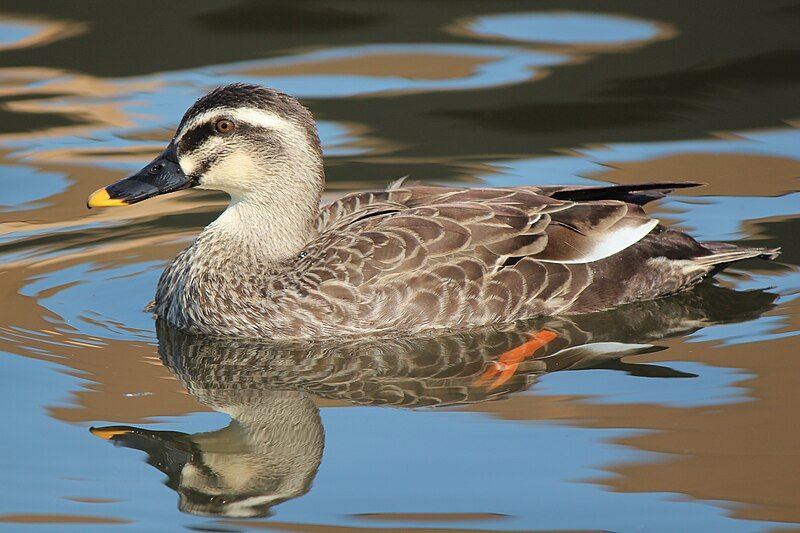
The eastern spot-billed duck is a dabbling duck found in East and Southeast Asia. It is closely related to the Indian spot-billed duck, and in the past, both of these species were referred to simply as the spot-billed duck.
They share a common feature – a yellow spot on their bills. This is where the species gets its name. The eastern spot-billed duck is a medium-sized duck characterized by a long, broad bill.
Its head is brownish-grey, its back and wings are dark grey-brown, and its chest and belly are white. Its legs and feet are orange-yellow.
The eastern spot-billed duck is a highly adaptable species in various habitats, including wetlands, grasslands, and agricultural land. It feeds mainly on aquatic vegetation, small invertebrates, and seeds.
The eastern spot-billed duck is not considered to be threatened, and its global population is estimated to be stable.
| Kingdom | Animalia |
| Phylum | Chordata |
| Class | Aves |
| Order | Anseriformes |
| Family | Anatidae |
| Genus | Anas |
| Species | A. zonorhyncha |
16. Baer’s Pochard
Baer’s pochard is a species of diving duck native to eastern Asia. It is primarily a resident bird in North and Central China. However, it was once bred in the southeast of Russia and Northeast China.
During winter, the Baer’s pochard migrates to more southern areas, such as China, Vietnam, Japan, and India. It is classified as a monotypic species, meaning it has no recognized subspecies.
The holotype of the species was collected from the middle Amur region. This means that the specimen was used as the basis by which the species was described and classified.
| Kingdom | Animalia |
| Phylum | Chordata |
| Class | Aves |
| Order | Anseriformes |
| Family | Anatidae |
| Genus | Aythya |
| Species | A. baeri |
17. Common Goldeneye
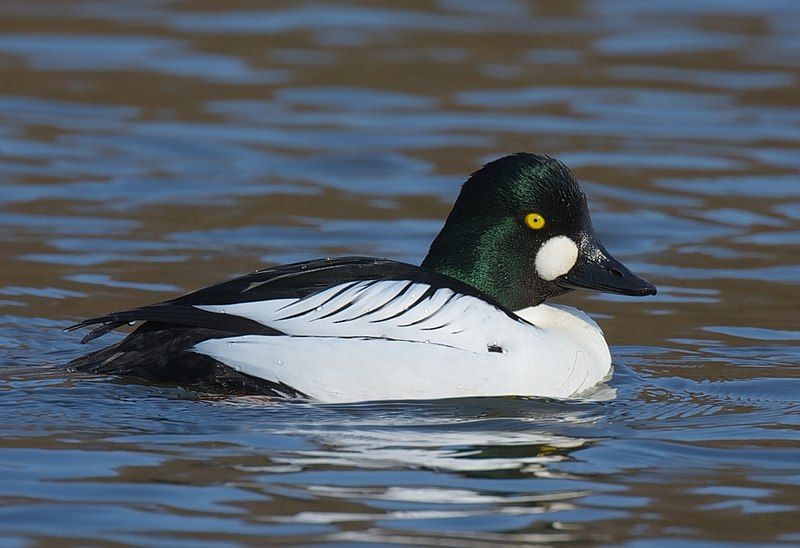
The common goldeneye is a sea duck of the genus Bucephala, classified as a medium-sized sea duck. Its closest relative is the Barrow’s goldeneye, a species that is quite similar in appearance.
The genus Bucephala is derived from the Ancient Greek language and refers to the odd shape of the bufflehead, which has a bulbous head shape. The common goldeneye is found in many parts of the world, including Europe, Asia, and North America.
The bird is known for its distinctive black and white plumage, and it is also known for its loud call. It is a migratory species seen in many areas during the winter months. The goldeneye will travel to more northern regions during the summer months to breed.
The common goldeneye is a widespread species among birdwatchers and is hunted for its meat.
| Kingdom | Animalia |
| Phylum | Chordata |
| Class | Aves |
| Order | Anseriformes |
| Family | Anatidae |
| Genus | Bucephala |
| Species | B. clangula |
18. Hazel Grouse
The hazel grouse, also known as the hazel hen, is a small bird from the grouse family. It is a species that doesn’t migrate and is known to breed across the Palearctic region in countries such as Japan and Eastern and Central Europe.
This bird prefers to inhabit dense, damp, and mixed coniferous woodland, such as forests with spruces. It is usually found in areas with wet and mixed trees, providing them with protective cover from predators.
The hazel grouse can also take advantage of the food sources available in such environments, such as nuts, berries, and insects. The availability of such food sources also allows the hazel grouse to sustain their population in the area.
| Kingdom | Animalia |
| Phylum | Chordata |
| Class | Aves |
| Order | Galliformes |
| Family | Phasianidae |
| Genus | Tetrastes |
| Species | T. bonasia |
19. Mallard
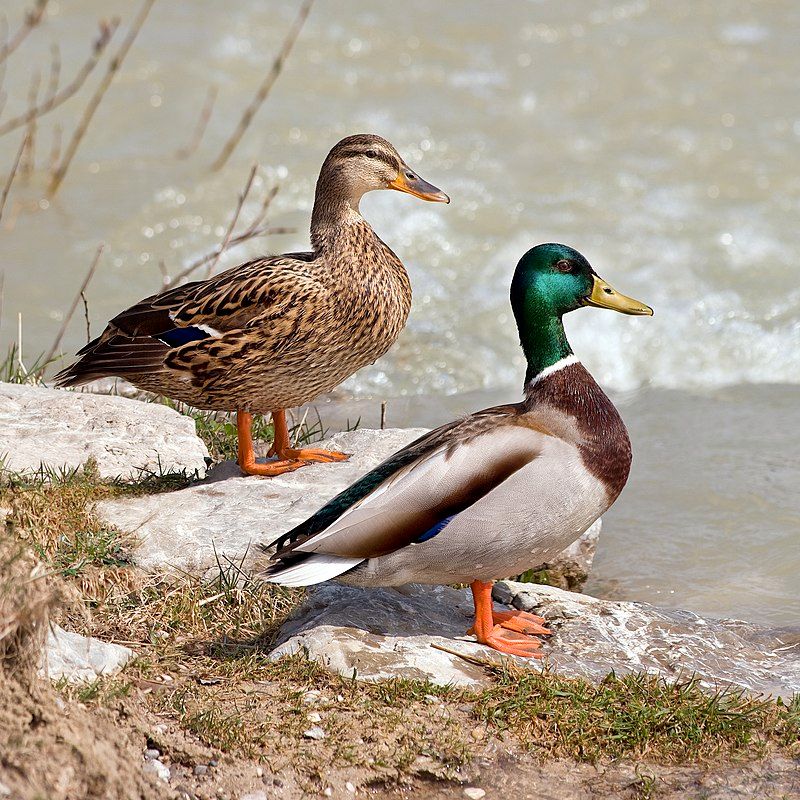
The Mallard or Wild Duck is a species of dabbling duck found in many parts of the world. It breeds across temperate and subtropical Americas, Eurasia, and North Africa regions.
In addition, the Mallard or Wild Duck has been introduced to New Zealand, Australia, Peru, Brazil, Uruguay, Argentina, Chile, Colombia, the Falkland Islands, and South Africa.
This species of duck is highly adaptable and can live in various ecosystems, including wetlands, grasslands, woodlands, and even urban areas. It is a common species and is considered one of the most abundant waterfowl.
Mallards are omnivorous, meaning they eat both plants and animals, and their diet includes grasses, seeds, aquatic insects, and even small vertebrates. They are highly social and often form large flocks.
The Mallard is a famous game bird, and people worldwide widely consume its meat.
| Kingdom | Animalia |
| Phylum | Chordata |
| Class | Aves |
| Order | Anseriformes |
| Family | Anatidae |
| Genus | Anas |
| Species | A. platyrhynchos |
20. Smew
The smew is a small duck species and the only living member of Mergellus. Mergellus is derived from the word Mergus, while labellum is derived from the Latin word albus, which means “white.”
This genus is closely related to Mergus and sometimes even included in the same genus, though it is more likely to be related to the goldeneyes. The smew is a medium-sized duck with a white body, black head, and neck. Its wings are white and black, and its tail is black.
It has a distinctive white streak on its back and a yellow or orange bill. The smew is a diving duck and feeds mainly on small fish and aquatic invertebrates.
It is found in northern Europe, northern Asia, and North America and is listed as a species of most minor concern by the IUCN.
| Kingdom | Animalia |
| Phylum | Chordata |
| Class | Aves |
| Order | Anseriformes |
| Family | Anatidae |
| Genus | Mergellus |
| Species | M. albellus |
21. Tufted Duck
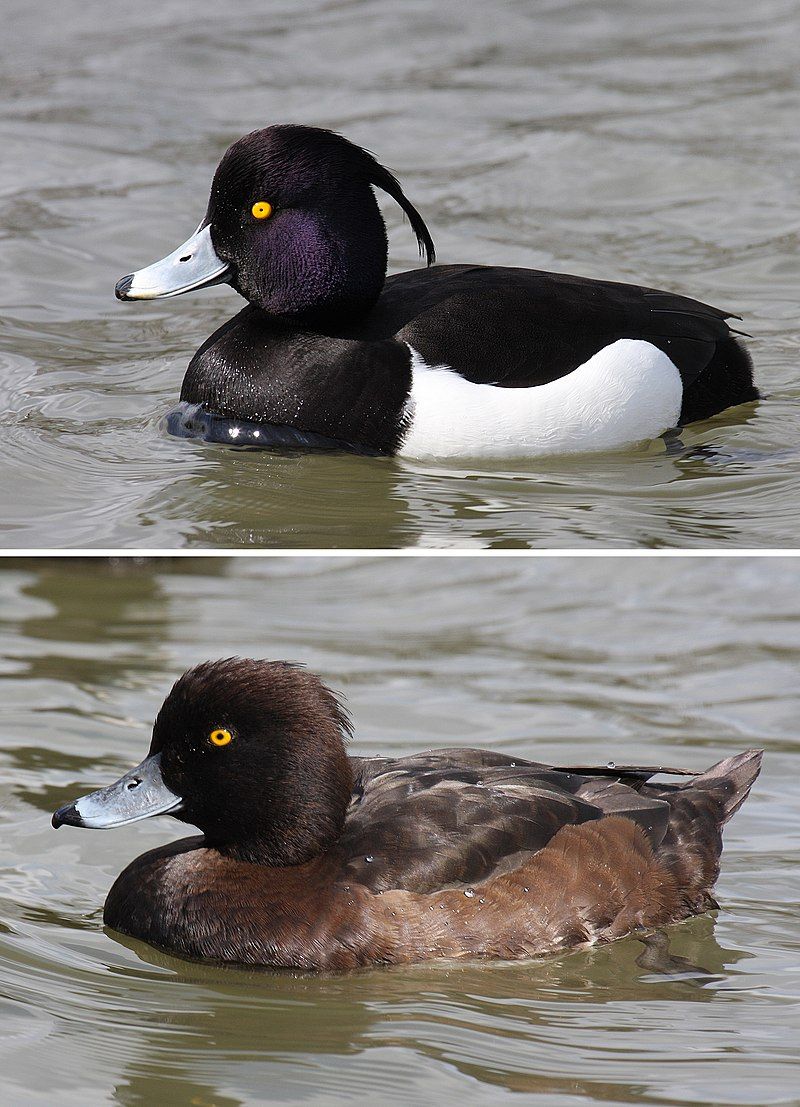
The tufted duck, also known as the tufted pochard, is a small diving duck found in northern Eurasia. It is estimated that this species has close to one million ducks.
The scientific name for the tufted duck is derived from Ancient Greek and Latin words. The Greek word aithuia was used by authors such as Hesychius and Aristotle to refer to an unidentified seabird. The Latin words fuligo and gula mean “soot” and “throat,” respectively.
This likely refers to the tufted duck’s distinctive black and white markings. The tufted duck also has a large white tuft on its head, probably giving it its name.
This duck species is particularly adapted to cold climates, as its dense feathers and a thick layer of down help it retain heat. It is also a strong swimmer and can dive up to three to five meters deep.
The tufted duck feeds on aquatic vegetation, small invertebrates, and other food sources. It is a migratory species that can travel long distances during winter.
| Kingdom | Animalia |
| Phylum | Chordata |
| Class | Aves |
| Order | Anseriformes |
| Family | Anatidae |
| Genus | Aythya |
| Species | A. fuligula |
22. Common Pochard
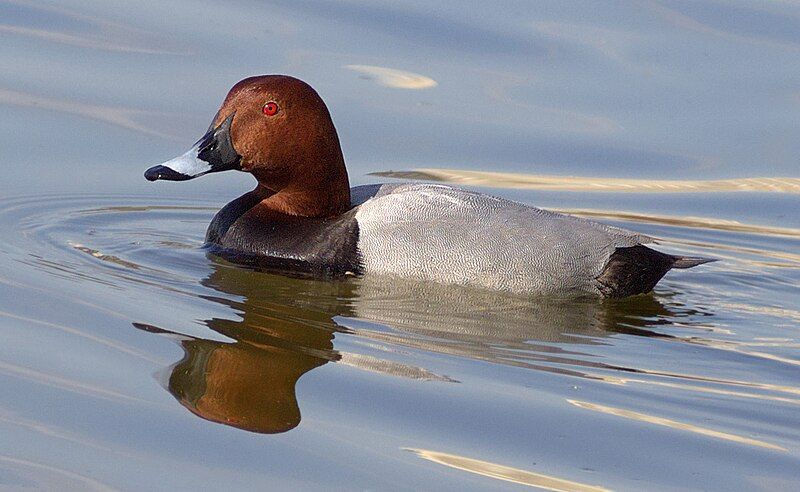
The common pochard is a medium-sized diving duck. Its scientific name originates from two sources – Greek Lithuania and Latin Farina. Aithuia refers to an unidentified seabird mentioned by prominent ancient authors such as Hesychius and Aristotle.
Ferina is derived from the Latin word ferus, which means wild. Thus, the translation of ferina is ‘wild game.’ This reference to the wild nature of the common pochard is also reflected in its diving habits.
The common pochard is known for its ability to dive underwater to search for food, a behavior that is generally associated with wild animals. It is, therefore, fitting that its scientific name includes references to both wildness and seabird.
| Kingdom | Animalia |
| Phylum | Chordata |
| Class | Aves |
| Order | Anseriformes |
| Family | Anatidae |
| Genus | Aythya |
| Species | A. ferina |
23. Black Stork
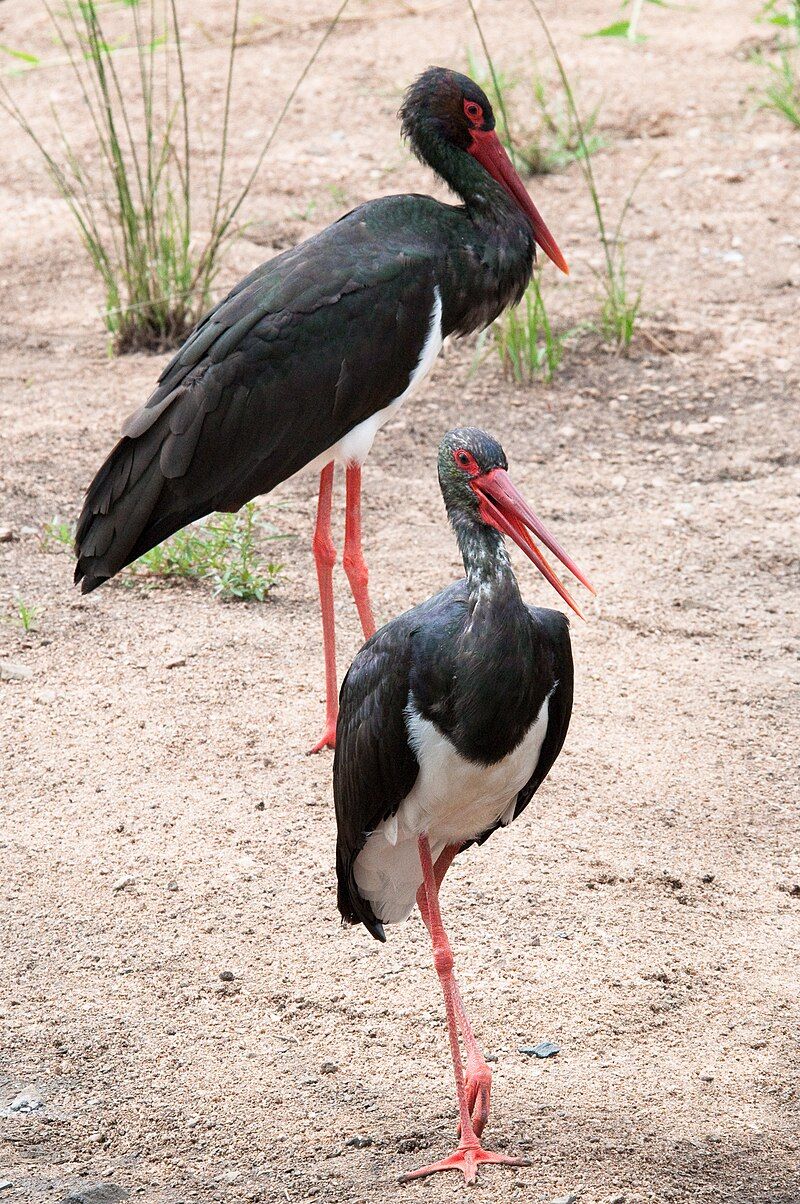
The black stork is a large bird belonging to the family Ciconiidae, a type of stork. It was first scientifically described by the Swedish naturalist Carl Linnaeus in the 10th edition of his book Systema Naturae, which is an extensive catalog of animals and plants.
This book is considered the first modern scientific work of zoology and botany. The black stork is a large bird that can reach a wingspan of up to 150 cm and a weight of up to 3 kilograms.
It has black plumage and long red legs and is found in wetlands, rivers, and wet grasslands.
The black stork is a migratory species found in Europe, parts of Asia, and Africa. The black stork is mainly an insectivore but also feeds on amphibians, small mammals, and fish. It is a solitary bird usually found alone or in small groups.
Breeding activities take place during the spring and summer months.
The female lays one to four eggs in a nest made of sticks and twigs. The black stork is listed as vulnerable by the International Union for Conservation of Nature due to the destruction of its breeding and wintering habitats.
Conservation efforts are in place to protect the species, such as establishing protected areas and promoting sustainable land-use practices.
| Kingdom | Animalia |
| Phylum | Chordata |
| Class | Aves |
| Order | Ciconiiformes |
| Family | Ciconiidae |
| Genus | Ciconia |
| Species | C. nigra |
24. Greylag Goose
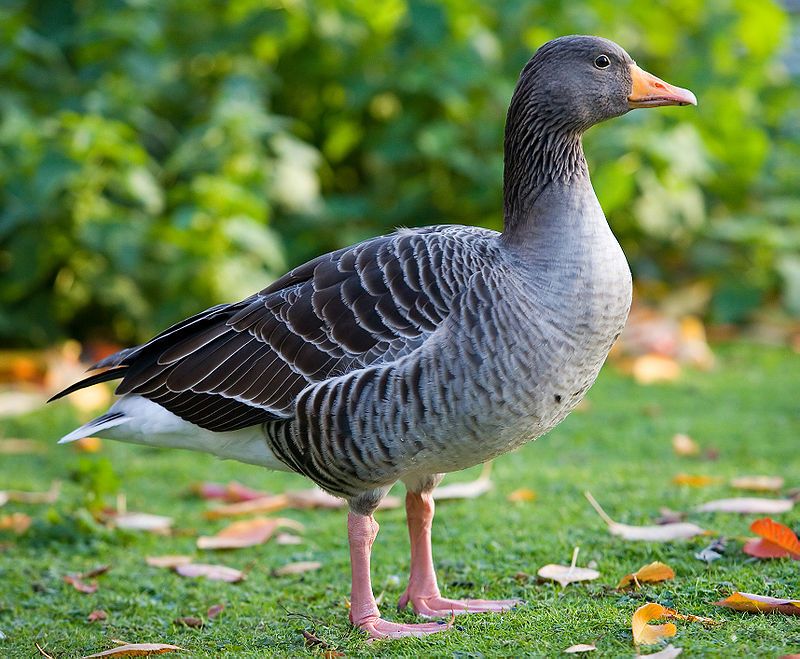
The Greylag Goose is a species of large goose belonging to the waterfowl family Anatidae and is the type species of the genus Anser. It has a unique plumage consisting of a mottled and barred grey and white pattern. Its beak is orange in color, and its legs are pink.
The Greylag Goose is a large bird with a body length of approximately 75 centimeters and a wingspan of up to 1.5 meters. It is usually found in wetlands and fields, where it feeds mainly on plant material.
The Greylag Goose is a migratory species, with some populations breeding in northern Europe and spending the winter in more southerly climates. It is a famous bird in some parts of Europe and is hunted for sport and food.
| Kingdom | Animalia |
| Phylum | Chordata |
| Class | Aves |
| Order | Anseriformes |
| Family | Anatidae |
| Genus | Anser |
| Species | A. anser |
Conclusion
The diverse avian population of Gyeonggi Province offers a rich tapestry of birdwatching experiences for enthusiasts and nature lovers alike.
From the majestic cranes gracing the wetlands to the colorful songbirds adorning the forests, each species contributes to the ecological balance and beauty of the region.
The 24 birds highlighted here represent just a fraction of the avian wonders waiting to be discovered in Gyeonggi.